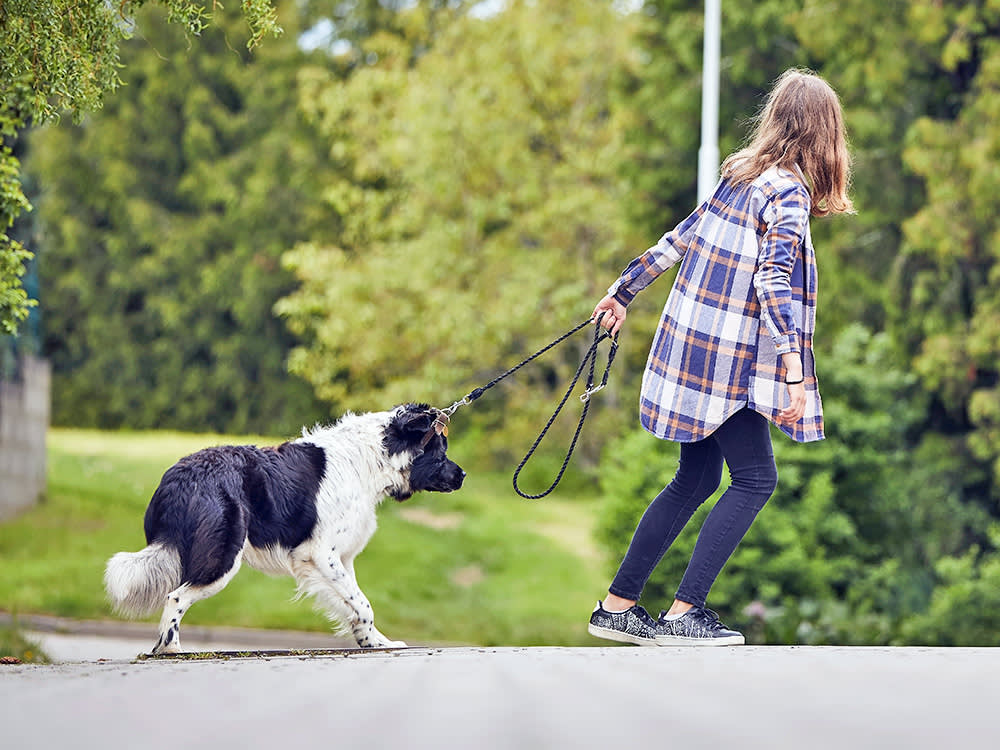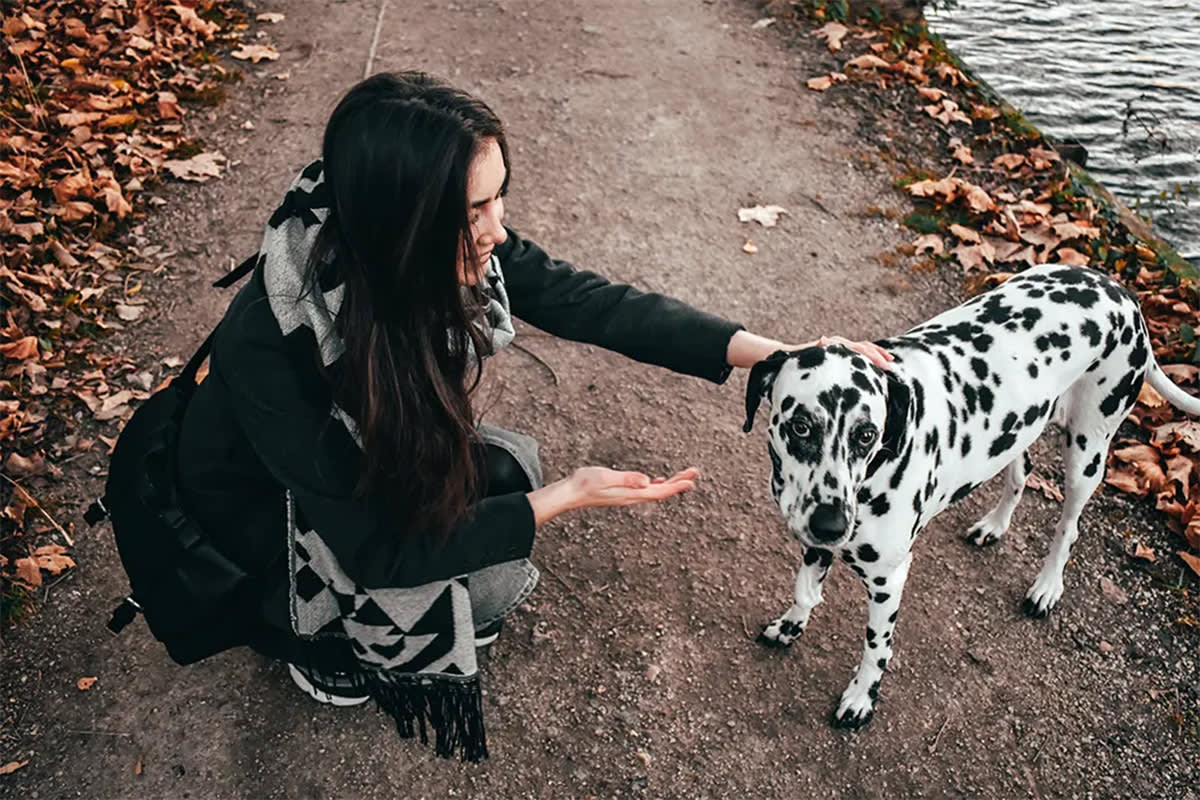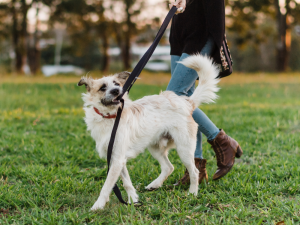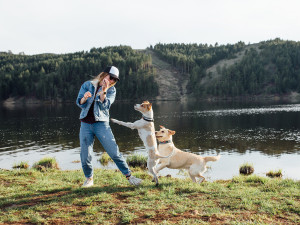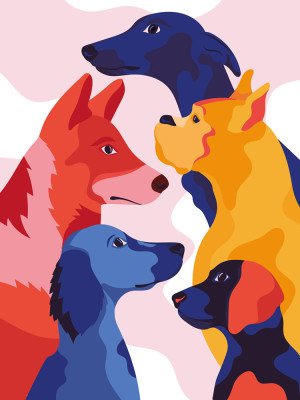Why Do Dogs Suddenly Refuse to Budge?
And how do you get them moving?
George is not budging. A neighbor has stopped by to let him outside, but he refuses to move. We won’t go so far as to call George stubborn, but he is never going to get off this couchopens in new tab. Ever.
This Golden Retriever gets it—he’s at the beach and sees no reason to leaveopens in new tab, so he’s not moving either.
And when this beagle plopped down and refused to finish her hike, she got her own personal Uberopens in new tab.
Every pet parent has experienced it: You’re having a perfectly lovely time, then suddenly your dog just…stops. If you have a 5-pound Yorkie, it’s easy enough to scoop them up. But when you live with a Great Dane, you’ve got to get to the bottom of things.
How much do you spend on your pet per year?
We spoke to three experts to answer the question: Why won’t my dog budge?
Is it normal for dogs not to budge?
The idea of not budging isn’t surprising, according to Dr. Andrew Findlaytoropens in new tab, a veterinarian and editorial advisory board member at dvm360, who regularly sees clients who are reluctant to get going.
“I have seen them sit and refuse to walk, even lie down and play dead when they didn't want to walk any further,” he says.
Tatiana Yastremskiopens in new tab, a certified trainer and behavior consultant, knows the feeling: She’s seen many dogs put on the brakes. One day she was out walking with her own pup, Mena, when Mena suddenly stopped just as they entered the park.
“It’s a place she’s been to many times before, but for some reason on that day, the moment she stepped paws in the park, she quickly turned around and started to pull me back home,” says Yastremski, who works with dogs at St. Hubert’s Dog Training and Behavior Centeropens in new tab in Madison, New Jersey.
While it was unusual, she’s hesitant to call Mena or any dog stubborn when they get stuck. In fact, anytime pet parents start to call their dogs “stubborn,” Yastremski suggests they reassess the situation. In fact, she says, it may be totally normal for your dog to suddenly freeze—and it’s a sign you need to pay attention to why.
“There are times that I hear from dog parents that their dog’s doing x, y, and z is because they are stubborn,” she says. “Listen up, dog parents: Your dogs are not stubborn.”
In fact, they may be trying to communicate something. “Learning dog body languageopens in new tab and knowing your dog is super important, as these two things could help you better understand the reason behind your dog becoming stuck,” she says.
Why do dogs refuse to budge?
If you’ve seen this viral videoopens in new tab of the Golden Retriever who was having a very fine day and did not understand why he had to get back in the car—and therefore decided to lie down in the middle of a parking lot—you might have a sense of why some dogs plant themselves and refuse to budge.
But it’s not always so clear cut.
“It is difficult to know what is going on in a dog’s head without understanding their previous learning experiences and what was going on in the environment right before these behaviors started,” says Dr. Kristin Kuntzopens in new tab, a board certified veterinary behaviorist at Insight Animal Behavior Servicesopens in new tab in Chicago.
However, Dr. Kuntz notes that there are a few common reasons dogs might be reluctant to move:
They are “highly motivated” to stay put (they think they will get more attention or they’re just comfortable)
They’re frightened of something in their environment (a loud noise, fast-moving vehicles, or other animals or people)
They’re in pain or have another form of discomfort (think an injury or arthritis)
Yastremski agrees: “They could be tired, not feel well, they could have possibly stepped on something and hurt their paw, they may be older and don’t want to walk too far, or they perceive something stressful or threatening,” she says.
How to decode your dog
Dr. Kuntz says that dogs who are annoyed, bored, stressed, or uncomfortable will use their body language to communicate.
For example, panting or limping may be signs of painopens in new tab. Tucking their tail, licking their lips, or avoiding eye contact may mean they’re frightened by somethingopens in new tab. Study up on dog body languageopens in new tab to get an idea of what your pup is trying to “say.”
“The dog may be communicating fear, stress, discomfort, and/or frustration,” Yastremski says. “It’s important for pet parents to understand what the purpose of the behaviors is, especially if those behaviors never existed before.”
But if the reason is murky—or it’s just new behavior—it’s best to pay a visit to your veterinarian to decode what’s going on. From there, you can work on a plan to help your pup feel better.
“It is important to understand the ‘why’ behind the lack of movement,” Dr. Kuntz says. “If the dog is painful, then activity restriction, pain management, and any other indicated treatment should be pursued.”
And if it’s a trigger that’s frightening your dog, that can also be managed.
“Then the pet parent should work with their veterinarian and a positive reinforcement trainer to create a treatment plan to help the dog become more confident around the scary trigger,” Dr. Kuntz notes.
How to ask your dog to move (in the nicest way possible)
But sometimes it’s fairly clear that our dogs are just having an amazing time—and don’t want to miss out. So, how do you convince them to go home?
“As for what we can do about it, our dogs are clever,” says Dr. Findlaytor. If you know that your dog is frustrated about leaving the park—even though it’s been two hours—it’s OK to humor them a little. “Getting frustrated isn't the solution, although sometimes laughing is absolutely the solution,” he says.
But eventually everyone must leave the party—what then?
You should be thinking about this before it even happens. Good training ahead of time can help you in that moment.
Figure out what motivates your dog, advises Dr. Kuntz, noting that it could be food, pets, or praise. “Use that as a reward for performing the desired behavior,” she says. “For example, when the dog is walking next to their pet parent, it is important for the pet parent to reward that good behavior.”
Then when you do get stuck, use those motivators to encourage your dog.
Yastremski suggests:
Encouraging your dog verbally using a “happy and excited voice”
Using treats to lure them forward
Trying to get them to do tricks they already know
Seeing if they’ll follow a dog who’s already walking ahead
As for Yastremski, when her dog Mena refused to move in the park that day, she encouraged her with kind words and treats, but Mena wouldn’t budge.
So, Yastremski carefully read Mena’s cues: “Her ears were back and pretty much plastered to her head which can be a sign of worry and caution,” she says. “She was moving very quickly and kept turning around repeatedly to check-in with me. The pupils in her eyes were mildly dilated. All I could think of is that she was perceiving a threat.”
Yastremski realized that there was a good reason Mena had decided not to take her usual route.
“She could have picked up the scent of a wild animal passing through, and since there are bears and coyotes where I live, there was a high probability of that,” she says. “Once we entered our neighborhood, Mena was back to her old self again, walking calmly, sniffing and checking-in with me while at my side.”
